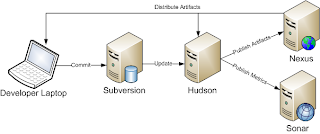During the process of using CC, I learned the following valuable lessons I wanted to share.
First, once every 24 hours is not frequent enough for continuous integration. As mentioned above, I use to set up CI environments to build once every 24 hours. When I initially set up CI, I was asked to set the builds to run every 4 to 6 hours. There were skeptics who believed any more frequent builds triggered by repository activity would interfere with a team so new to CI and cause unnecessary anxiety. However, every 4 to 6 hours was a problem when trying to set up and configure CI initially so I set the CI to check the repository every minute and if something changed to wait for 5 minutes of inactivity before starting the build. Fortunately, I forgot to change it to a less frequent iteration and the minute check made into the final configuration. We discovered that the short frequencies actually provided the best results by giving everybody comfort since they got immediate feedback. Plus without a frequent build, one bad build could cause the red lava lamp to be lit all day.
Second, there are multiple audiences for the builds so there is a need for a continuous integration build and a nightly build. The audience of a continuous build should be the developers themselves. Developers need quick feedback to provide confidence. They need to know what they checked in to the repository works outside their development environment and what they check out of the repository works. So, this build should focus on code compiling, passing the unit tests and being able to be packages and possibly deployed. The second audience is management and architects. Managers are often trying to collect metrics from frameworks like NCSS and JUnit (number of unit tests). Architects are often interested in code quality reports such as PMD and unit test code coverage. These types of reports take longer to produce and don’t need to run continuously. A separate build that runs at midnight is perfect for executing metric and code quality reports. Of course developers should be able to run these reports at any point in time in their development environments since the same build scripts should be used by both the developers and CI environment.
Third, a CI web site like the one already in Hudson and provided by Sonar is a very valuable communication tool. While developers need to be notified immediately of build problems via email, IM or lava lamps, other such as managers do not. A website can provide the information they need at their convenience.
Forth, lava lamps are a fun way to provide a visual indicator of the build. I initially thought the idea was rather hokey but I was wrong. If you want to learn how to integrate lava lamps with CruiseControl check out Mike Clark's Pragmatic Automation web site (http://www.pragmaticautomation.com/cgi-bin/pragauto.cgi/Monitor/Devices/BubbleBubbleBuildsInTrouble.rdoc).


